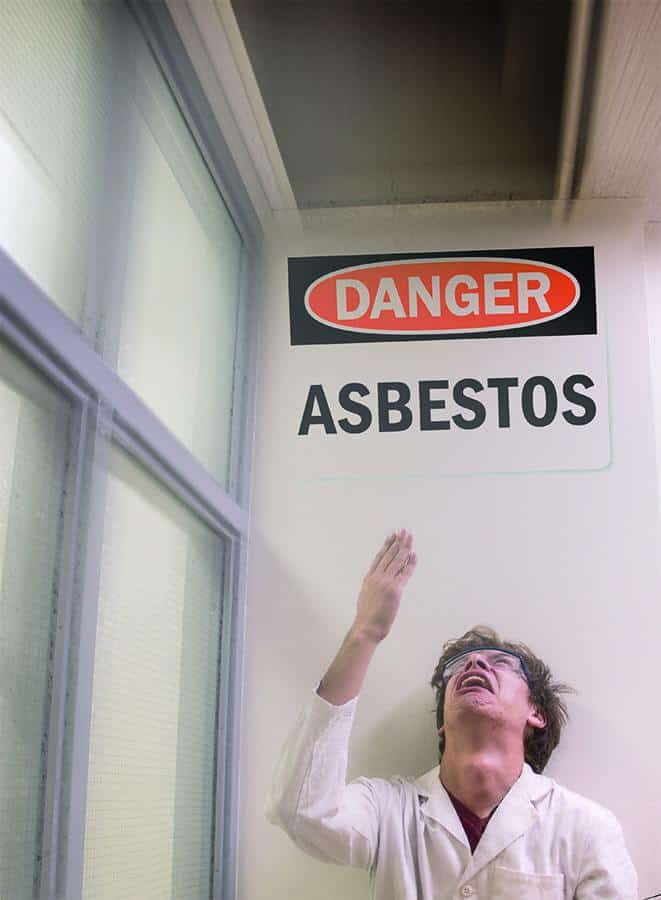University keeping tabs on presence of asbestos

author: ethan williams | staff writer

Asbestos can be found on many different types of materials, including ceiling finishing and windows. credit jaecy bells
Asbestos not harmful unless airborne, University says
You may not see it, but it’s there. Asbestos, which was, at one time, a popular building product, is present in many University of Regina buildings, both at the main and College Avenue campuses.
The product was used up until the mid to late eighties as a fire retardant in buildings all over the world, but the fibres within it are now known to be cancer causing, leading to diseases such as mesothelioma.
Darren Cherwaty, the U of R’s Director of Health, Safety, and Wellness, says the university is well aware of the issue, and is making sure people know that there is no immediate danger to their health.
“That’s why we’re communicating about it. Unless asbestos becomes airborne, it’s not a health hazard in that regard. When we talk about abrading or destroying materials with power tools, that’s when asbestos becomes airborne. Unless we’re undergoing a renovation or construction project or abrading it with some kind of power tool, that asbestos is not going to be released.”
The university has a webpage that is dedicated to disseminating information regarding asbestos. The page includes an inventory document, which shows the exact locations of where asbestos is present on both campuses.
Ranking top on the list of areas that include asbestos is College West. Materials that have asbestos include things such as pipes, roof drains, and fire stop materials.
Both the Classroom and Laboratory buildings also have large amounts of the material, and it is found mostly in the vinyl tiling and along the window ledges.
Other buildings on campus that have asbestos-containing materials include a few rooms on the first floor of Ad-Hum, multiple rooms in the basement, first, and second levels of the old wing of the Kin building, a small area in the basement of Campion College, and several rooms on each floor of the Archer Library.
Each building on the College Avenue Campus also contains the material, and it is found on objects ranging from electrical cable to vinyl floor tiles.
Additionally, Cherwaty says that the most recent reports of asbestos came from another on-campus building.
“[Asbestos was] more recently found in the Education Building in the ceiling tiles in that area, and that’s why we’ve gone through and put the red dots on those materials.”
The website also includes a breakdown of management procedures to be followed by university staff in order to protect people on campus from any danger from asbestos.
Cherwaty also explained that both campuses have been completely inspected, and that it is constantly monitored.
“We did a thorough inventory in 2012, and we’re doing another inventory. And we do an annual inventory, which is required under legislation as well. If we find any materials that could potentially become friable, those are inspected annually. We have people who go through our entire campus to make sure.”
Additionally, the university has a plan in case an emergency should arise, for instance if a piece of asbestos should suddenly crumble from a wall or ceiling.
“Let’s say we have some kind of damage or water release in an area where we have asbestos containing material. We have contractors who are available to come in who are asbestos abatement experts, and they can come in and immediately remediate a situation.”
Cherwaty went on to say that there are different levels of remediation. In minor instances, the U of R Facilities Management team is equipped with the skills to handle the substance, whereas if it is a larger issue, the university would bring in a special contractor to deal with the situation.
But what about a complete removal of asbestos from both campuses? In many cases, as soon as asbestos is discovered in any building around the world, there are plans to have it fully removed. As for the U of R, Cherwaty says there are no plans at this point to undertake a complete renovation or removal of any areas containing asbestos, as there is no immediate danger to students and staff.
“If in our annual report we find any material that’s in poor shape, where these the potential for it to become friable, we will immediately remove that area or abate that area. If there is a renovation that’s going to go on, certainly at that time we examine the area and see if it’s in the drywall mud, or the floor tiles, or the ceiling tiles. That would certainly be looked at as part of the renovation to remove it. If we’re in the area and we’re doing any kind of demolition, absolutely we will look at removing it as best we can.”
So how can students be informed about asbestos and how to deal with it? Cherwaty says an email has gone out in the past, making students aware of the presence of the substance, but says he would be interested in hearing from students as to how they would like to be informed about it.
Information about asbestos on campus is available on the U of R’s Health, Safety, and Wellness website by clicking the personal safety and asbestos tabs. The site includes the inventory and an FAQ sheet, as well as additional details.








